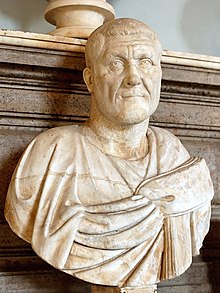
Back Maximín o Tracio AN ماكسيمينوس ثراكس Arabic ماكسيمينوس الاول ARZ I Frakiyalı Maksimin Azerbaijani Максімін Фракіец Byelorussian Максимин Трак Bulgarian Maximinus Iañ Breton Maksimin I Tračanin BS Maximí el Traci Catalan Maximinus Thrax Czech
| Maximinus Thrax | |||||||||
|---|---|---|---|---|---|---|---|---|---|
 Bust, Capitoline Museums, Rome | |||||||||
| Roman emperor | |||||||||
| Reign | March 235 – c. June 238[a] | ||||||||
| Predecessor | Severus Alexander | ||||||||
| Successors | Pupienus and Balbinus | ||||||||
| Rivals | Gordian I and II | ||||||||
| Born | c. 173 (?) Thracia | ||||||||
| Died | c. June 238 (aged ~65) Aquileia, Italy | ||||||||
| Spouse | Caecilia Paulina | ||||||||
| Issue | Gaius Julius Verus Maximus | ||||||||
| |||||||||
| Father | Unknown, possibly Micca[5] | ||||||||
| Mother | Unknown, possibly Ababa[5] | ||||||||
Gaius Julius Verus Maximinus "Thrax" (c. 173 – 238) was a Roman emperor from 235 to 238. Born of Thracian origin – given the nickname Thrax ("the Thracian") – he rose up through the military ranks, ultimately holding high command in the army of the Rhine under Emperor Severus Alexander. After Severus was murdered in 235, he was proclaimed emperor by the army, beginning the Crisis of the Third Century, a 50-year period of instability and civil war. He is often remembered for his unusual height, although the veracity of this is disputed.
His father was an accountant in the governor's office. Maximinus was the commander of the Legio IV Italica when Severus Alexander was assassinated by his own troops in 235. The Pannonian army then elected Maximinus emperor.[6]
In 238 (which came to be known as the Year of the Six Emperors), a senatorial revolt broke out, leading to the successive proclamation of Gordian I, Gordian II, Pupienus, Balbinus, and Gordian III as emperors in opposition to Maximinus. Maximinus advanced on Rome to put down the revolt, but was halted at Aquileia, where he was assassinated by disaffected elements of the Legio II Parthica.
Maximinus is described by several ancient sources, though only Herodian's Roman History is contemporary. He was a so-called barracks emperor of the 3rd century;[7] his rule is often considered to mark the beginning of the Crisis of the Third Century. Maximinus was the first emperor who hailed neither from the senatorial class nor from the equestrian class.
- ^ a b Rea, J. R. (1972). "O. Leid. 144 and the Chronology of A. D. 238". Zeitschrift für Papyrologie und Epigraphik. 9: 1–19. JSTOR 20180380.
- ^ Burgess, Richard W. (2014). Roman imperial chronology and early-fourth-century historiography. Historia Einzelschriften. Stuttgart: Steiner. pp. 67–69, 93–95. ISBN 978-3-515-10732-7.
- ^ Peachin, Michael (1990). Roman Imperial Titulature and Chronology, A.D. 235–284. Amsterdam: Gieben. ISBN 90-5063-034-0.
- ^ Cooley, Alison E. (2012). The Cambridge Manual of Latin Epigraphy. Cambridge University Press. p. 497. ISBN 978-0-521-84026-2.
- ^ a b Historia Augusta, Maximinus, 1:6
- ^ Pat Southern (16 December 2003). The Roman Empire from Severus to Constantine. Routledge. p. 64. ISBN 978-1-134-55381-5.
- ^ Kerrigan, Michael (2016). The Untold History of the Roman Emperors. Cavendish Square. p. 248. ISBN 9781502619112. Retrieved 19 March 2019.
Cite error: There are <ref group=lower-alpha> tags or {{efn}} templates on this page, but the references will not show without a {{reflist|group=lower-alpha}} template or {{notelist}} template (see the help page).
© MMXXIII Rich X Search. We shall prevail. All rights reserved. Rich X Search